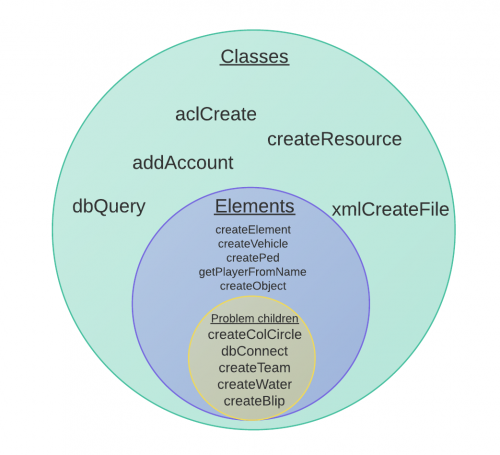ZH-CN/OOP介绍
此编程教程能够向你解释什么是OOP,教你如何来使用MTA的OOP功能。当前页面由thisdp翻译,英文原版由qaisjp撰写 Forum post.
关于OOP的介绍
OOP 是指 面向对象程序设计. OOP是将所有函数都封装入每一个接口进行访问,这样的接口我们称之为实例。一个实例可以是由元素类、数据库类、玩家类、载具类等实例化出来对象。
一般来说,在Lua中,所有东西都是面向过程的,因此你会写出如下代码:
local vehicle = createVehicle(411, 0, 0, 3) setVehicleDamageProof(vehicle, true) setElementFrozen(vehicle, true) setElementHealth(vehicle, 1000) setElementVelocity(vehicle, 0.2, 0.2, 0.2) destroyElement(vehicle)
More often than not, you know what you're dealing with. The variable almost always links back to the type, you would name a vehicle that exploded as explodedVehicle, or at-least in context you would understand that exploded implies a vehicle when in the onVehicleExplode event. So you have to write a long function and refer to the vehicle manually when working procedurally. Painful. Object orientated programming is very different to this and works with each "object" individually. Instead of having to call a function and referencing it inside the call, you actually call the function INSIDE the class.
You probably think everything you can create and pass to functions are elements. A vehicle is an element. A player is an element. Anything that is an element is also a class. Connections create an instance of a class, but "connection" isn't an element, it's an instance - an object. Throughout the tutorial when I say object, I don't mean createObject (unless I actually mention it), but to make things clearer I will avoid mentioning physical objects as I write this article. Here is a fancy venn diagram I created to show the simple organisation of classes and elements.
The functions on the left are sorted to show what kind of category the returned value rests in. We've got Classes, Elements and "Problem children". Problem children aren't real categories written in the code, just functions that break rules. Everything you can play with are classes: resources, vehicles, and teams.
All elements are classes, you can do:
destroyElement(ped)
but you can't do:
destroyElement(resource)
Problem children are weird things. You can't do all the functions mentioned in (actually, all elements don't allow the full assortment of functions to be applied to them, but I've especially mentioned a few of them) in the "Element functions" section of the functions list, but you can do destroyElement() on them. There are children of classes, for example, with players, the system goes like: "Element -> Ped -> Player". All Players are Peds and all Peds are Elements. Not all Peds are Players, and certainly not all Elements are Players. The main point here is that almost everything that you can create or retrieve and then reuse later use a class.
Instead of the code before, the code could be replaced with this:
local vehicle = createVehicle(411, 0, 0, 3) vehicle:setDamageProof(true) vehicle:setFrozen(true) vehicle:setHealth(1000) vehicle:setVelocity(0.2, 0.2, 0.2) vehicle:destroy()
It works pretty similar to how a table works, it's just like customTable.setSomething() except the use of : makes Lua convert customTable:setSomething() convert to customTable.setSomething(customTable). This is pretty internal stuff about syntactic sugar and you don't really need to worry much about it.
Those functions are pretty useful, but there are more changes with OOP, I'll explain this below.
实例化和变量
OOP移除了函数的所谓"创建"的意义,取而代之的是实例化。例如原来是createVehicle,在OOP中,我们只需要使用Vehicle,它们以同一种方式运作,或者说,我们可以认为Vehicle = createVehicle。是不是很科幻,很花里胡哨呢?
它们的唯一区别就在于,使用OOP的情况下,你可以省略掉一些多余的部分,Vehicle没有这些多余的部分,但是玩家(Player)是肯定有的。比如本来要写成getPlayerFromName(),在OOP的语法下,只需要使用Player.getFromName()。是不是非常简单呢?这也确实是一种组织代码的好方法。
| Tip: Vehicle() 也是可以用的,因为它会访问 Vehicle.create 函数,这样就能够让你在创建一个对象的时候省略 .create 了 |
既然OOP比面向过程更高级,也已经继承了许多东西过来,但是为了化繁为简,所有函数对应的变量要求最多只能有一个输入。我们已经把getElementDimension() 缩短为 element:getDimension() 了,但是我们还可以更进一步: element.dimension。是不是很像个变量呢?它可以像普通的变量一样进行赋值,就比如:
local function incrementDimension()
local player = Player.getRandom() -- 随机抽取一位幸运玩家
player.dimension = player.dimension + 1 -- 维度增加1
end
setTimer(incrementDimension, 60*1000, 10) -- 设置一个60秒的定时器,一共运行10次,每次运行调用函数incrementDimension
上述代码设置了一个60秒的定时器,一共运行10次,也就是说在接下来的10分钟内每分钟都会随机抽取一位幸运玩家,让其维度+1。
向量
player.position当然也可以用!但是你怎么能够用一个变量。。。来同时改变三个参数?答案是 向量。 向量类非常强大,他们有多种形式。为了能够在这里解释的清楚一点,我将会在接下来的例子中使用3维向量。使用向量也是一件特别简单的事,当然,如果你开心的话。只要是出现了位置(position)的地方,你就可以用向量。
因此,下面这个例子是关于使用向量来创建一辆载具并且移动带地图中心。
-- 首先,创建一个3维向量 local position = Vector3(300, -200, 2) -- 远处某一点 local vehicle = Vehicle(411, position) -- 在这点创建一辆车 vehicle.position = centreOfMap - Vector3(300, -200, 0) -- 把这辆车移动到地图中心处上方两个单位。
没错,我使用了减号。向量对于位置和旋转角度而言只是一个非常高级的工具,你可以通过向量对他们使用数学运算。所以,你能在第一行看到,我以坐标300,-200,2创建了一个3D向量,然后第二行我创建了一辆车在那个位置。
vehicle.position 返回一个向量,它有点像没有"()"的setElementPosition,仅仅是一个变量。因此,在第三行,我改变了这个代表着车辆坐标的。这里就是数学起作用的地方了,把上述向量运算展开就能得到如下等价的表达式:
x = 300 - 300 y = -200 - -200 z = 2 - 0
向量的数学运算比较复杂,但是它无疑能够使用出数学的各种神奇的魔法效果,找一找有关向量和矩阵的实用页面链接,进去浏览一下文档,来帮助理解上述代码。
如何理解OOP文档
OOP语法的使用文档非常易懂,并且也是由面向过程的语法提供支持。为了尽可能保持简单,所有的文档都统一了格式:
OOP 语法 什么是OOP?
- 提示: Set the variable to nil to execute removePedFromVehicle
- 方法: ped:warpIntoVehicle(...)
- 变量: .vehicle
- 对称函数: getPedOccupiedVehicle
- 有的时候页面中会增加一个"提示"来说明此OOP函数的一些不同点以及特殊功能。
- 方法可以 以player: 或者 Player. 开头,前者代表玩家(Player)实例(player),比如(setPlayerHealth),后者是玩家(Player)类下的静态方法,比如(getRandomPlayer)。
- 对称函数能够允许你找到当前函数的对称部分,比如(setElementPosition)的对称函数为(getElementPosition)。这个在绝大部分情况下都是可以通过当前函数页面来推断出来的。
如果你想要对wiki做出一些贡献,请务必浏览简体中文OOP模板,或者英文版本的OOP模板
实用的页面连接
其他实用的OOP相关的页面
